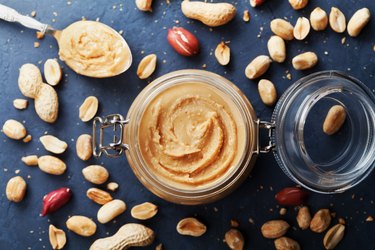
Peanut butter sandwiches are a mainstay of grade school lunches, but can still be a healthy part of an adult diet. As a source of protein and healthy fat, try peanut butter for weight gain.
It's easy to find, and you can incorporate it into a myriad of meals, from savory to sweet. Use peanut butter to add nutrition and calories to snacks and meals.
Video of the Day
Video of the Day
Peanut Butter for Weight Gain
Gaining healthy weight requires dedicated diet and exercise, says the Mayo Clinic. You can certainly pile on pounds by eating an excess of chips, soda, pizza and sweets, but these unhealthy foods contain sugar, fat and very little nutrition.
Combine a diet of nutrient-rich food with exercise to support muscle gain and bone strengthening, rather than just getting fat.
Whether you're trying to gain weight after an illness, to fill out a naturally thin frame, to acquire a more athletic build, or to become stronger and less frail, peanut butter supports your goal.
To increase your size by between 1/2 pound and 1 pound per week, add about 250 to 500 calories per day of nutrient-rich calories rather than junk food, as advised by the University of Colorado.
According to the USDA, one serving of peanut butter, equal to 2 tablespoons, contains almost 200 calories. Add one serving to two meals and one snack each day and you've increased your daily intake by 600 calories, resulting in gain of a little over 1 pound per week.
Read more: 9 Simple and Satisfying Peanut Butter Snacks
Eat for Breakfast and Snacks
At breakfast, spread peanut butter on toast or a bagel. Use it to top whole-grain pancakes or waffles. Stir 2 tablespoons into hot cereal, such as oatmeal. Dip sliced apples and bananas into the nut butter.
Have peanut butter with woven wheat crackers for a quick snack. Make a peanut butter, banana and honey sandwich on whole-wheat bread to stash in a backpack or purse for a between-meal snack. Carry individual packets of peanut butter as an even more convenient snack when you're on the road.
Add Peanut Butter to Meals
A peanut butter sandwich makes an easy-to-pack, calorie-dense lunch. Serve it with sides such as an apple, cut-up carrots, yogurt and milk to create a meal with peanut butter for weight gain.
For more grown-up meals, make a dipping sauce from peanut butter, soy sauce, brown sugar, rice wine vinegar, garlic and ginger. Serve it with grilled meats, Asian-style noodles or a stir-fry served with ample brown rice.
Use peanut butter instead of tahini pureed along with chickpeas, lemon juice and garlic to make a homemade hummus. Eat the hummus with whole-wheat pita or whole grain crackers.
Peanut butter can also be added to winter squash soups, some salad dressings and North African stews.
Recover With Peanut Butter
Resistance training is key when you're trying to gain muscle weight. But during a workout you inevitably burn calories, which can interfere with creating your calorie surplus.
Have a post-workout snack containing carbohydrates and protein to replace those calories, foster muscle growth and facilitate muscle repair.
Blend a scoop of whey protein powder with 22 grams of protein, 1 cup of skim milk, 2 tablespoons of peanut butter and a large banana for a 519-calorie shake, according to the USDA. Add ground flax seed for another 20 calories per teaspoon.
Try These Alternatives
Although peanut butter is a good choice for weight gain, experiment with other nut butters — or nut butter blends made from multiple types of nuts — for flavor and nutritional variety. Almond and cashew butters have approximately the same number of calories as peanut butter.
Almond butter offers more bone-strengthening calcium, while cashew butter has a little more brain building omega-3 fatty acids. Cashew butter is lower in protein though, with just 4 grams per 2-tablespoon serving. Use these nut butters to add calories in the same way you'd use peanut butter.
- USDA FoodData Central: "Skim Milk"
- USDA FoodData Central: "Peanut Butter"
- USDA FoodData Central: "Flax Seed"
- USDA FoodData Central: "Whey Protein Powder"
- USDA FoodData Central: "Banana, Raw"
- University of Colorado: "Eating Strategies to Gain Weight"
- USDA FoodData Central: "Cashew Butter"
- Mayo Clinic: "What's a Good Way to Gain Weight If You're Underweight?"
- Food and Wine: Spicy Peanut Sauce
- Food and Wine: Ground Nut Stew